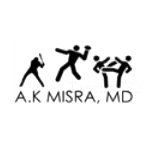Recently Dr. A.K. Misra, medical director at U.S. HealthWorks in South San Francisco, spent two weeks on assignment at Olympic Park in Colorado Springs, Colo., as a guest sports medicine physician where he worked with Olympic athletes and hopefuls. Here he shares some of his unique experience. Dr. Misra is a medical director at U.S. HealthWorks in South San Francisco and is double board certified in Sports Medicine and Internal Medicine.
Q: Could you give us a brief overview of what you did in Colorado Springs and who you worked with in terms of athletes?
A: Colorado Springs is the flagship center and headquarters for the U.S. Olympic Committee (USOC). Like the other two Olympic centers in America (Chula Vista, California, and Lake Placid, New York), the focus is to provide exceptional Sports Medicine care to all Olympians and Paralympians requiring care.
The athletes we cared for ranged from established gold medal Olympians and Paralympians to Olympic and Paralympic hopefuls. Most of the athletes ranged in age from their teens into their twenties. It is one of the most humbling experiences one can have, and in many ways the Paralympians are the most inspirational of all the athletes for obvious reasons.
During my assignment, the three other sports medicine experts that made up my medical team included a physical therapist, an athletic trainer and a chiropractor. Given the heavy musculo-skeletal focus of the practice structure, the four of us worked together as a team to meet all the unique needs of our athletes given our respective areas of certification and expertise.
Considering the high caliber of some of the athletes we would care for, working for the USOC has parallels to my Sports Medicine work in Major League Baseball (see prior blog). It’s so fulfilling, such a pleasure and an extremely high privilege. In addition, what made this work so exceptional (for me at least) is that it was an unbelievable way to serve my country, which to my mind has few parallels. On some level it may be the most humbling aspect of this entire experience. It is my hope to be able to continue to serve my nation accordingly going forward, especially now with this assignment completed. It is the experience of a lifetime and one I highly recommend to all sports medicine physicians as an outstanding professional endeavor.
Q: How does a Sports Medicine physician get chosen for this opportunity?
A: There is an application process and a number of factors are taken into consideration before one is ultimately selected. The selection process requires an extensive background check and pertinent, substantial experience in Sports Medicine. Endorsements from peers and supervisors are essential too, ideally from those who have experience directly with the Olympic Games and/or Olympic athletes.
Fortunately, I met this requisite due to my Sports Medicine fellowship when we (my mentors Dr. Joshua Hackel and Dr. James Andrews) took care of Olympians at The Andrews Institute, an experience which was not exclusive to only American Olympians. My experience at the USOC had many parallels to my time at The Andrews Institute as well because of the elite level of athletes we routinely cared for and their expectations.
Q: What was your day-to-day routine like?
A: My responsibilities kept me busy six days a week and, much like my work at U.S. HealthWorks, there was both a set schedule and a walk-in component to my daily routine. We had access to cutting-edge technology like musculo-skeletal ultrasound and a Sports Science department in addition to the resources one would need to provide standard urgent care. Internal Medicine and acute rehabilitation oriented consults alongside care coordination with orthopedic surgeons were part of my experience. I also conducted literature research for complex medical concerns for unique populations.
During the assignment, we stayed on the Colorado Springs Olympic Training Center campus 24-7. My colleagues and I had a shared call schedule in case any medically urgent instances or emergencies arose. Our responsibilities also included live/real-time Sports Medicine event coverage. One becomes very much part of the Olympic community during this time as we lived in and ate at the same facilities as the athletes. It was not uncommon to run into Olympians of other nations (i.e. Asian, European, Middle Eastern, African and Central American) who would send their athletes to the Colorado Springs Olympic Training Center for training assignments.
Q: What type of sports/training was going on during your visit?
A: While my responsibility was strictly the Sports and Internal Medicine care of the athletes during my training assignment with the USOC, there were athletes from many sports during my stay including, but not limited to, swimming, gymnastics, cycling, fencing, wresting and shooting. Certain sports are seasonal. The sort of athlete you are likely to tend to depends on the timing of one’s assignment with the USOC and how the different sports are scheduled per their respective National Governing Body’s training assignments at the Olympic Training Center in Colorado Springs.








